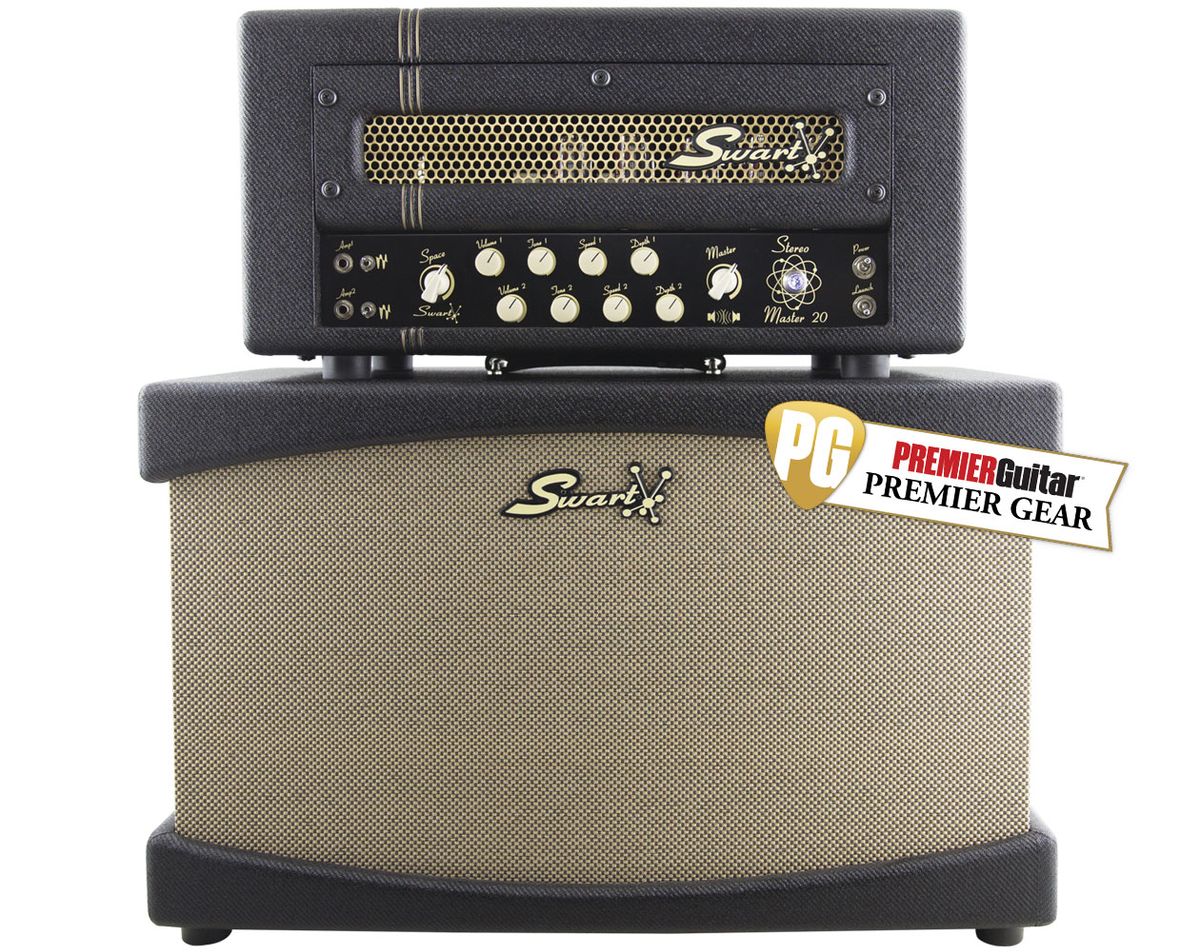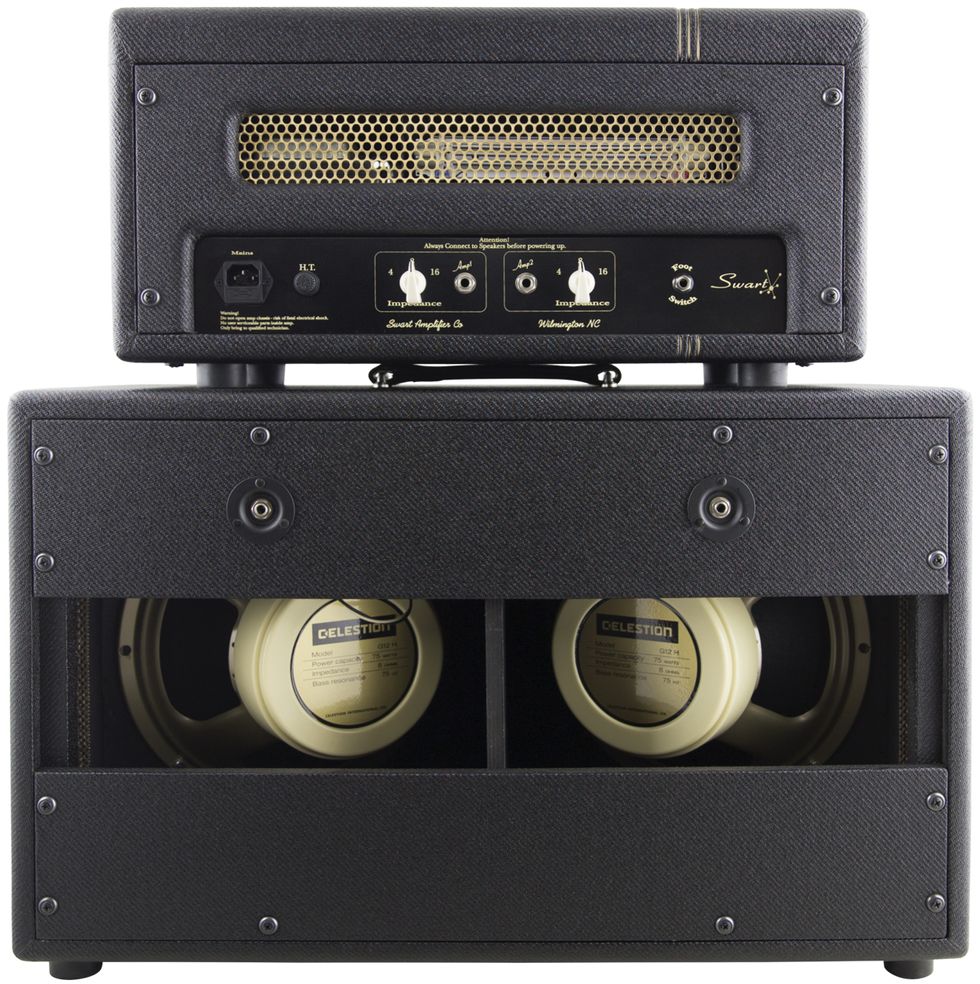
Think stereo amps are just for fancy delay-pedal addicts? This ingenious/delicious 6V6 design will make you think again.
Recorded using a Squier Vintage Modified Telecaster with Curtis Novak Tele-V bridge and JM-V pickups, and a Gibson Les Paul Traditional with 57 Classics. Amp miked with a Royer R-121 and a Shure SM57 feeding an Apogee Duet going into GarageBand with no EQ-ing, compression, or effects.
Clip 1: Telecaster (with pickup selector in middle position for rhythm segment, then in bridge position for lead segment) feeding Swart’s amp-1 input with toggle in bottom position, “space” and master volume at maximum, amp-1’s controls set with volume at 1 o’clock, tone and tremolo speed at max, and trem depth at 10 o’clock, while amp-2’s controls had volume at max, tone and trem speed at minimum, and trem depth at 3 o’clock.
Clip 2: Les Paul neck pickup feeding Swart’s amp-1 input with toggle in top position, “space” at 3 o’clock, master volume at maximum, amp-1’s controls set with volume at 11 o’clock, tone at 9 o’clock, tremolo speed at minimum, and trem depth at 10:30, while amp-2’s controls had volume at 10:30, tone at noon, trem speed at minimum, and trem depth at 3 o’clock.
RatingsPros:Fantastic tones. Incredible touch sensitivity. Gorgeously spacious reverb. Independent tremolo circuits facilitate both 3-dimensional wonder and delectable disorientation. Cons: Can’t sum outputs for use with mono cabinet. Street: $2,399 street (head), $859 street (2x12 cabinet) Swart Stereo Master 20 swartamps.com | Tones: Ease of Use: Build/Design: Value: |
Stereo rigs typically entice players heavily into sophisticated delay, reverb, and pitch-shifting effects—not exactly the target market for Michael Swart’s line of vintage-inspired designs. But you don’t have to be a fan of the latest algorithm cruncher from Eventide or Strymon to fall in love with Swart’s Stereo Master 20.
Originally conceived as a means of packing a single chassis with the harmonic possibilities you get from through two differently voiced amps, the SM20 became something more compelling. Whether you plug straight into its “amp-1” input, or route stereo signals from your space-station pedalboard to both of the SM20’s inputs, the Stereo Master sends your signal to two 20-watt, 6V6-powered amps, each of which can then feed either its own cab or the deceptively normal-looking 2x12 shown here.
The kickers: 1) Each amp has its own deliciously hypnotic tube-driven tremolo circuit, and 2) this Swart 2x12 has an internal cabinet divider isolating a pair of diagonally oriented Celestion Creambacks (other options are available as well). Still not grokking why this is so cool for both old- and new-school types? Let’s just say the SM20 is all about the glorious, oft-ignored world of contrasts.
All-Class Class AB
Swart offerings have long evoked some of the coolest visual aspects of early amps while still looking fresh and unique. The Stereo Master manifests this in details like lacquered black tweed and gold accents over finger-jointed solid-pine cabinets, and a front-panel presentation that feels Atomic Age without being hokey. Circuit-wise, the SM20 combines the tremolo, reverb, and simple volume-and-tone preamp circuit from Swart’s Gibson Scout-inspired Atomic Space Tone with the input EQ toggle from Swart’s STR-Tremolo and Antares models (more on this later). Craftsmanship is stellar: Components are neatly handwired on a central turret board, with longer wires snugged up against the chassis and routed at right angles, and the tube sockets and pots are all chassis mounted. Tube access is a cinch, too. Remove five screws, and the front panel comes off to yield easy, no-flashlight-required access. That’s cool for routine maintenance, or for light modifications like switching 6L6s for the stock 6V6s in either or both amps (sans biasing!), or swapping the stock 5AR4 rectifier with a 5Y3 for more sag in the response. Oh, and the output transformer is impressively gigantic.
The Conundrum: Vertiginous or Enveloping?
I tested the SM20 with a 57 Classic-equipped Gibson Les Paul Traditional and a Squier Vintage Modified Telecaster Custom with Curtis Novak JM-V and Tele-V pickups, both of which sounded absolutely fantastic. This can be attributed to two main factors: First, any qualms about perceived limitations of a single tone control are decimated by the fact that you can set different tone recipes on each amp, and the SM20’s clever 3-position input toggles, which select different cathode-bypass capacitor values in the first gain stage to determine which frequencies head to the second stage.

The middle position is flat, the top yields more bass presence, and the bottom cuts low end to accentuate mids and highs. This feature is so handy for dialing in different guitars that you might wish it were footswitchable (blues and blues-rock players will go gaga for the beefier setting). Second, the amps’ identically voiced tone knobs (which increase midrange and treble as they’re turned clockwise) are expertly tuned. There’s plenty of the velvety character you expect from a vintage 6V6 design, but at minimum the tone knobs don’t get flubby or indistinct, and at max tones are lean and incisive but never shrill.
All this would make the Stereo Master 20 compelling even if its control set were halved and all four 6V6s were dedicated to making it a single 40-watt generator of classic American tones. But it’s the Swart’s capability for contrasts that really make it a fantastical sound playground.
After spending hours exploring settings, I settled on a favorite: Plugging directly into amp-1, flicking its input toggle to the mid-and-treble-accentuating position, and dialing its volume to 2 o’clock and its tone to maximum, then setting amp-2’s volume to max and its tone to minimum. With the Paul, this sounded beefy and on-the-verge, with various levels of pick attack producing everything from warm jazz tones to country spank, jangle, and mean rock and punk sounds. A Telecaster yielded similar but tamer results with more single-coil leanness and chime—while a clean boost from a J. Rockett Audio pushed the amp to its most bristling output. Here, the bridge pickup slashed viscerally, while middle and neck-pickup tones conjured all sorts of ringing, bell-like loveliness.
This is only half the SM20’s magic though, because its ingenious cab’s raison d’être is tremolo mayhem. Whether you play it safe and dial-in identical speed and depth settings on each amp, use trem on one side only, keep speed settings the same but contrast depth-knob positions, or go full-wacko with vertigo-inducing contrasts on both knob pairs, you might find enough captivating options to forego other effects.
Except, of course, reverb. It’s virtually impossible to hear a Swart amp and not be gobsmacked by its spring reverb tones, and the SM20’s (available only on amp 1) is no exception. If, like me, you’re a reverb junkie who gets irked if you can’t dial a tank past 5 without getting loads of trebly, pinging grodiness, you’ll love that the Stereo Master’s cavernous response lets you go full-bore without the trails becoming an annoying distraction.
The Verdict
I’m pretty much at my word limit, but really what more is there to say? If you’re looking for something truly, addictively different in a classic-voiced amp, you really ought to check out Swart’s Stereo Master 20. It’s not cheap, but the extra dollars go toward more unique and impactful ends than they might on many similarly priced boutique amps.


